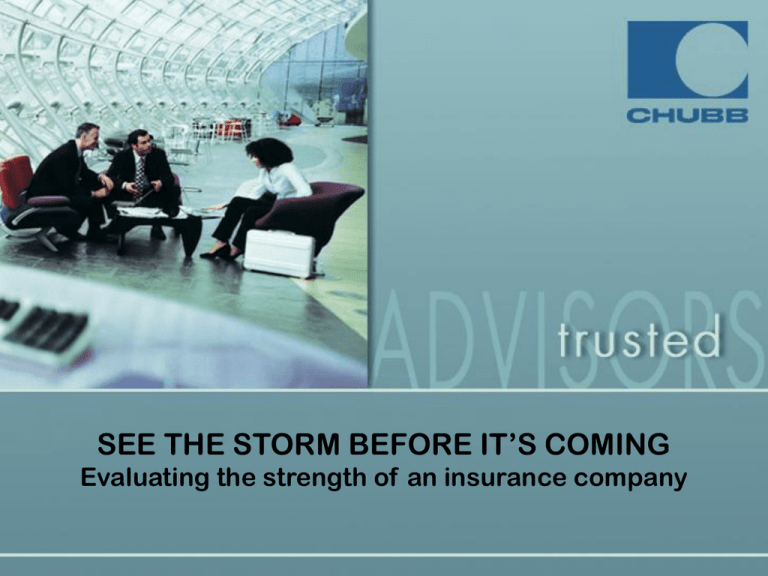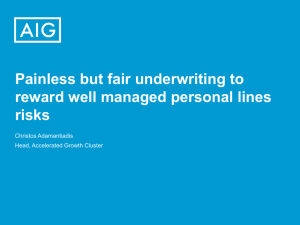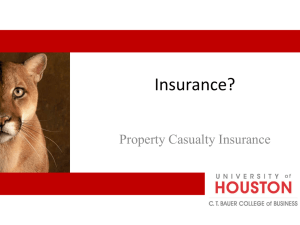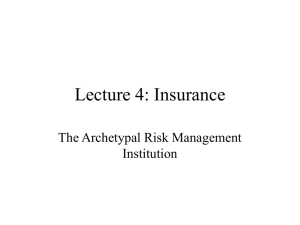See The Storm Before It's Coming Evaluating the strength of
advertisement

SEE THE STORM BEFORE IT’S COMING Evaluating the strength of an insurance company INSURANCE • Insurers’ do not pose the a systemic risk like some banking activities do. • Insurers do not rely on wholesale market funding for liquidity. They fund themselves through premiums, with long term capital to support risk taking positions. • Without insurance, no one could afford to take the risks necessary to grow a healthy economy. Cyclical Industry • Soft Market: where underwriting is less stringent so it's easier to obtain coverage, there's more competition between companies so the rates drop and it is easier to obtain the coverage so overall, the underwriting standards go down. • Often during periods of soft insurance markets a lot of claims are filed causing companies to raise underwriting requirements, causing rates to go up, and that would lead to a hard insurance market. U.S. P/C Insolvencies vs. Combined Ratio 1971-2002 54 companies went insolvent in 1985, peaked in 1992 with 63 insolvencies, started to peak again in 2002 with 43 insolvencies. 70 140 Insolvencies Combined Ratio 60 130 50 120 40 110 30 100 20 90 10 80 0 70 1971 1976 1981 1986 1991 1996 2001 Source: A.M.Best Co. Special Report “P/C Industry – 2001 Insolvencies”, June 18, 2002 Insurance Industry Stats: • 2001 to 2005 Hard Market - Industry took lots of rate • 2006 to 2010 Soft Market - Lots of reserve releases • There have been 550 Property and Casualty Failures since 1970, total paid out – $26.8 billion. • Combined Ratio of 100 produced an Industry ROE of 1979 = 16% , 2005 = 10% , 2009 = 7% • PRESSURE = less investment income, more catastrophic claims, litigious society, stressed economy, smaller premiums. Financial Strength Matters AGENDA • Key measurements for assessing insurer financial strength • Using financial ratings • Key measurements for assessing the overall health of the P&C insurance industry Stressors for Troubled Companies • • • • • • • • Catastrophes Rapid Expansion Significant Change Reinsurance Failure Alleged Fraud Inadequate Pricing/Reserve Affiliate Problems Investment Problems/Overstatement of Assets Underlying Cause- Internal • Management risk • Internal governance and control risk • Controller and group risk Underlying Cause - External • Economic cycle and condition risk • Social, technical, demographic, political, legal, tax, etc. risk • Market competition risk • Catastrophe or extreme event risk Primary Causes of P&C Impairments (1969 to 2008) Alleged Fraud Catastrophe Losses Reinsurance Failure Deficient Loss Reserves Rapid Growth Investment Problems/Overstates Assets Miscellaneous Impairment of Affiliate *A.M Best 2009 Guide to Understanding Insurance Ratings Significant Change in Business AIG Has $4.1 Billion Cost on Inadequate Reserves at Property-Casualty Unit • February 9, 2010: American International Group Inc. said higherthan-forecast claims costs cut fourth-quarter profit by $4.1 billion, and $2 billion previously designated to repay its bailout will be used to bolster the property-casualty unit. The insurer reached an agreement with the U.S. Treasury Department permitting the company to keep $2 billion of proceeds from the sale of Star Life Insurance Co. and Edison Life Insurance Co., New York-based AIG said today in a statement. Funds will be used by the Chartis property-casualty unit for losses tied to coverage including workers’ compensation and asbestos liability. AIG is adding to reserves, a sign that it underestimated the cost of claims, while rivals including Travelers Cos. have been taking profits after determining they had set aside more funds than necessary. • Two types of reserves: Case and IBNR Primary Causes of Life/Health Impairments (1976 to 2008) Significant Change in Business Alleged Fraud Miscellaneous Investment Problems Rapid Growth Reinsurance Failure Inadequate Pricing Affiliate Problems Recent Cases • Credit Crisis of 2008 – $180 billion in government funding for AIG • Hurricane Katrina – Insured losses = 47.4 billion • Hurricane Ike – Insured losses = 12.1 billion *Look for symptoms before it is too late Measuring the Financial Health of An Insurance Company • An insurance policy is only as secure as the company that issues it • There are qualitative and quantitative measures that are important for testing the health of an insurance company Profitability Test • Combined Ratio (after policyholder dividends) – Loss and LAE Ratio – Loss and Loss Adjustments/Net premiums earned – Underwriting Expense Ratio- Commissions and U/W Expenses/Net premiums earned – Policyholder Dividend Ratio- policyholder dividend/net premiums earned • Reserves are not part the loss ratio until paid. • HO are short tailed so need to run a low 86% c/r. • Auto have long tails and can run at 95% c/r. Profitability Test **From a profit perspective, the industry experienced an underwriting profit in three of the last 10 years (2004, 2006, and 2007). Prior to 2004, the property and casualty market did not produce a combined ratio below 100% since 1978. Leverage Test • Underwriting Leverage – Current premium writings – Reliance on reinsurance – Reserves • Financial Leverage • Asset Leverage – Asset quality – Diversification – Liquidity Operational Performance Test • • • • Underwriting performance Investment income Capital gains/losses Total operating earnings Qualitative Test • Internal company risk management • Business profile • Quality of management Simulation Gives Us A New Measure Of Risk The probability of a decline in underwriting profits (Value-at-Risk) is a useful risk measure. Mean 20% probability of a 30% or greater decline in underwriting profit -70% -30% +25% (Mean) % Change in Underwriting Profit +50% Using Financial Ratings • Financial strength ratings: – – – – A.M. Best Standard & Poor’s Moody’s Investor Services Fitch Ratings A.M. Best • Financial strength ratings – An independent opinion of an insurer’s financial strength and ability to meet its ongoing insurance policy and contract obligations • Based on a comprehensive quantitative and qualitative evaluation of a company’s: – Balance sheet strength – Operating performance; and, – Business profile Best’s Financial Strength Ratings • • • • • • • • A++, A+ A, AB++, B+ B, BC++, C+ D E F Superior Excellent Good Fair Marginal Poor Regulatory Supervision In Liquidation Secure Vulnerable (3% of Insurance Co’s are A++, 25% A+, 50% A or A-) (Independent agents do not represent anything less than B+) Standard & Poor’s • S&P Insurer Financial Strength Rating is a current opinion of the financial security characteristics of an insurance organization with respect to its ability to pay under its insurance policies and contracts in accordance with their terms. S&P Financial Strength Ratings Highly Likely to Meet Financial Commitments Extremely Strong AAA Very Strong AA Strong A Good BBB Vulnerable Marginal BB Weak B Regulation and Oversight • Credit rating agencies – SEC – IOSCO – NAIC • Insurance Companies – State insurance departments – State guaranty association – Federal Insurance Office (FIO): • Lack of information source or knowledge base (evident after 9/11 and Katrina) The Property & Casualty Industry 2008 Results • $450 billion in net premiums written • $1.5 trillion in assets • $480 billion in policyholders’ surplus Source: A.M. Best “U.S. Property/Casualty – 2008 Financial Review (4/13/2009) 1994-2007 U.S. Combined Ratio – Home and Auto, Industry 120% 110% 100% 109.9% 104.5% 103.5% 104.9% 102.7% 110.9% 104.5% 105.3% 96.4% 97.6% 99.8% 98.4% 90% 94.3% 92.0% 80% 19 94 19 95 19 96 19 97 19 98 19 99 20 00 20 01 20 02 20 03 20 04 20 05 20 06 20 07 70% Industry 1994-2006 U.S. Net W.P. Growth – Home and Auto, Industry Industry CAGR 1994-2006 CPI: 10.3% PL Industry: 5.1% 15 .0 % 10.1% 10 .0 % 5.7% 5.5% 5.7% 5.6% 5 .0 % 7.3% 4.1% 6.6% 2.0% 1.8% 0 .0 % 19 9 4 19 9 5 19 9 6 19 9 7 19 9 8 19 9 9 9.5% 2000 2001 Industry 2.6% 2002 2003 2004 2005 2.0% 2006 Strength of Recent Hard Markets by Real NWP Growth 25% 20% 1975-78 1985-87 2001-03 Real NWP Growth During Past 3 Hard Markets 1975-78: 8.6% 15% 1985-87: 14.5% 10% 2001-03: 9.1% 5% 0% -5% Current $ Real $ 1970 1971 1972 1973 1974 1975 1976 1977 1978 1979 1980 1981 1982 1983 1984 1985 1986 1987 1988 1989 1990 1991 1992 1993 1994 1995 1996 1997 1998 1999 2000 2001 2002 2003 -10% Note: Shaded areas denote hard market periods. Source: A.M. Best, Insurance Information Institute Too Big to Fail? • • • • • • • • • Stick to what you know Insurance ratings can be misleading Don’t chase extraordinary results Risk Management and U/W Profit is key When things go badly, they do so quickly Some risks cannot be avoided Affiliated businesses and distribution channels Expect more Federal regulation of insurance Avoid the “cheating phase” by posting adequate reserves which in turn supports accurate rates. 2011 Fitch Outlook • .9% Growth • Flat Investment Income • 103 Combined • Net Income fall by 30% • Key to Success is Risk Selection – Underwriting profit is a must. What Writing Company are you in?







